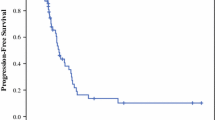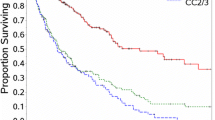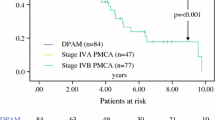Abstract
Background
Cytoreductive surgery (CRS) with hyperthermic intraperitoneal chemotherapy (HIPEC) has survival benefit in the treatment of selected patients with peritoneal carcinomatosis (PC) from appendiceal cancer (AC). We evaluated factors affecting the survival of patients with PC from AC after CRS/HIPEC.
Methods
A retrospective analysis of 387 CRS/HIPEC procedures performed between February 1998 and February 2013 identified 202 patients with PC from AC. Tumor histopathology, complete cytoreduction (CC 0–1), Peritoneal Cancer Index (PCI), and lymph node (LN) status were related to overall survival (OS) and progression-free survival (PFS) using the Kaplan–Meier method.
Results
Overall, 129 women (64 %) and 73 men (36 %), mean age 54 years (range 25–81), with a mean follow-up of 36 months were included in the study. Seventy-seven low-grade tumors (disseminated peritoneal adenomucinosis [DPAM]; 38 %) and 125 high-grade tumors (peritoneal mucinous carcinomatosis [PMCA]; 62 %) were identified. Five- and 10-year OS was 56 % and 47 %, respectively, with PFS of 44 % at 5 and 10 years. Five-year OS in DPAM patients was 83 %, with a 5-year OS significant difference related to CC 0–1 versus CC 2–3 (incomplete cytoreduction) [p = 0.021]. Five-year OS in PMCA patients was 41 %, with a 5-year OS significant difference related to CC 0–1 versus CC 2–3 (p < 0.001), PCI <20 versus PCI ≥20 (p = 0.002), and (–)LN versus (+)LN (p < 0.001). Grade III/IV complications were 16 %. No perioperative mortality was reported.
Conclusion
Positive LN, PMCA histopathology, and PCI ≥20 are negative prognostic factors, while CC 0–1 is a positive survival predictor in PC from AC treated with CRS/HIPEC. However, in patients with PMCA and PCI ≥20 in whom CC 0–1 was a potential outcome should not be denied CRS/HIPEC.



Similar content being viewed by others
References
Omohwo C, Nieroda CA, Studeman KD, et al. Complete cytoreduction offers longterm survival in patients with peritoneal carcinomatosis from appendiceal tumors of unfavorable histology. J Am Coll Surg. 2009;209(3):308–312.
McCusker ME, Cote TR, Clegg LX, Sobin LH. Primary malignant neoplasms of the appendix: a population-based study from the surveillance, epidemiology and end-results program, 1973-1998. Cancer. 2002;94(12):3307–3312.
Chua TC, Moran BJ, Sugarbaker PH, et al. Early- and long-term outcome data of patients with pseudomyxoma peritonei from appendiceal origin treated by a strategy of cytoreductive surgery and hyperthermic intraperitoneal chemotherapy. J Clin Oncol. 2012;30(20):2449–2456.
Elias D, Honore C, Ciuchendea R, et al. Peritoneal pseudomyxoma: results of a systematic policy of complete cytoreductive surgery and hyperthermic intraperitoneal chemotherapy. Br J Surg. 2008;95(9):1164–1171.
Elias D, Gilly F, Quenet F, et al. Pseudomyxoma peritonei: a French multicentric study of 301 patients treated with cytoreductive surgery and intraperitoneal chemotherapy. Eur J Surg Oncol. 2010;36(5):456–462.
Miner TJ, Shia J, Jaques DP, Klimstra DS, Brennan MF, Coit DG. Long-term survival following treatment of pseudomyxoma peritonei: an analysis of surgical therapy. Ann Surg. 2005;241(2):300–308.
Shankar S, Ledakis P, El Halabi H, Gushchin V, Sardi A. Neoplasms of the appendix: current treatment guidelines. Hematol Oncol Clin North Am. 2012;26(6):1261–1290.
Smeenk RM, Verwaal VJ, Antonini N, Zoetmulder FA. Survival analysis of pseudomyxoma peritonei patients treated by cytoreductive surgery and hyperthermic intraperitoneal chemotherapy. Ann Surg. 2007;245(1):104–109.
Votanopoulos KI, Shen P, Stewart JH, Levine EA. Current status and future directions in appendiceal cancer with peritoneal dissemination. Surg Oncol Clin N Am. 2012;21(4):599–609.
Baratti D, Kusamura S, Nonaka D, Cabras AD, Laterza B, Deraco M. Pseudomyxoma peritonei: biological features are the dominant prognostic determinants after complete cytoreduction and hyperthermic intraperitoneal chemotherapy. Ann Surg. 2009;249(2):243–249.
Baratti D, Kusamura S, Nonaka D, et al. Pseudomyxoma peritonei: clinical pathological and biological prognostic factors in patients treated with cytoreductive surgery and hyperthermic intraperitoneal chemotherapy (HIPEC). Ann Surg Oncol. 2008;15(2):526–534.
Halabi HE, Gushchin V, Francis J, et al. Prognostic significance of lymph node metastases in patients with high-grade appendiceal cancer. Ann Surg Oncol. 2012;19(1):122–125.
Van Sweringen HL, Hanseman DJ, Ahmad SA, Edwards MJ, Sussman JJ. Predictors of survival in patients with high-grade peritoneal metastases undergoing cytoreductive surgery and hyperthermic intraperitoneal chemotherapy. Surgery. 2012;152(4):617–624.
Halabi HE, Gushchin V, Francis J, et al. The role of cytoreductive surgery and heated intraperitoneal chemotherapy (CRS/HIPEC) in patients with high-grade appendiceal carcinoma and extensive peritoneal carcinomatosis. Ann Surg Oncol. 2012;19(1):110–114.
Omohwo C, Nieroda CA, Studeman KD, et al. Complete cytoreduction offers longterm survival in patients with peritoneal carcinomatosis from appendiceal tumors of unfavorable histology. J Am Coll Surg. 2009;209(3):308–312.
Bell JC, Rylah BG, Chambers RW, Peet H, Mohamed F, Moran BJ. Perioperative management of patients undergoing cytoreductive surgery combined with heated intraperitoneal chemotherapy for peritoneal surface malignancy: a multi-institutional experience. Ann Surg Oncol. 2012;19(13):4244–4251.
Levine EA, Stewart JH, Shen P, Russell GB, Loggie BL, Votanopoulos KI. Intraperitoneal chemotherapy for peritoneal surface malignancy: experience with 1,000 patients. J Am Coll Surg. 2013;218(4):573–85.
Gonzalez-Moreno S, Brun E, Sugarbaker PH. Lymph node metastasis in epithelial malignancies of the appendix with peritoneal dissemination does not reduce survival in patients treated by cytoreductive surgery and perioperative intraperitoneal chemotherapy. Ann Surg Oncol. 2005;12(1):72–80.
Halabi HE, Gushchin V, Francis J, et al. Prognostic significance of lymph node metastases in patients with high-grade appendiceal cancer. Ann Surg Oncol. 2012;19(1):122–125.
Arjona-Sanchez A, Munoz-Casares FC, Casado-Adam A, et al. Outcome of patients with aggressive pseudomyxoma peritonei treated by cytoreductive surgery and intraperitoneal chemotherapy. World J Surg. 2013;37(6):1263–1270.
Ronnett BM, Zahn CM, Kurman RJ, Kass ME, Sugarbaker PH, Shmookler BM. Disseminated peritoneal adenomucinosis and peritoneal mucinous carcinomatosis. A clinicopathologic analysis of 109 cases with emphasis on distinguishing pathologic features, site of origin, prognosis, and relationship to “pseudomyxoma peritonei”. Am J Surg Pathol. 1995;19(12):1390–1408.
Ronnett BM, Yan H, Kurman RJ, Shmookler BM, Wu L, Sugarbaker PH. Patients with pseudomyxoma peritonei associated with disseminated peritoneal adenomucinosis have a significantly more favorable prognosis than patients with peritoneal mucinous carcinomatosis. Cancer. 2001;92(1):85–91.
Jacquet P, Sugarbaker PH. Clinical research methodologies in diagnosis and staging of patients with peritoneal carcinomatosis. Cancer Treat Res. 1996;82:359–374.
Esquivel J, Elias D, Baratti D, Kusamura S, Deraco M. Consensus statement on the loco regional treatment of colorectal cancer with peritoneal dissemination. J Surg Oncol. 2008;98(4):263–267.
Sugarbaker PH. Peritonectomy procedures. Surg Oncol Clin N Am. 2003;12(3):703–27, xiii.
Sugarbaker PH. New standard of care for appendiceal epithelial neoplasms and pseudomyxoma peritonei syndrome? Lancet Oncol. 2006;7(1):69–76.
Sardi A, Jimenez WA, Nieroda C, Sittig M, Macdonald R, Gushchin V. Repeated cytoreductive surgery and hyperthermic intraperitoneal chemotherapy in peritoneal carcinomatosis from appendiceal cancer: analysis of survival outcomes. Eur J Surg Oncol. 2013;39(11):1207–1213.
Dindo D, Demartines N, Clavien PA. Classification of surgical complications: a new proposal with evaluation in a cohort of 6336 patients and results of a survey. Ann Surg. 2004;240(2):205–213.
Kuijpers AM, Mirck B, Aalbers AG et al. Cytoreduction and HIPEC in the Netherlands: nationwide long-term outcome following the Dutch protocol. Ann Surg Oncol. 2013;20(13):4224–4230.
Sugarbaker PH. Technical handbook for the integration of cytoreductive surgery and perioperative intraperitoneal chemotherapy into the surgical management of gastrointestinal and gynecologic malignancy. 4th ed. Michigan: The Ludman Company; 2005.
Teo MC, Tan GH, Tham CK, Lim C, Soo KC. Cytoreductive surgery and hyperthermic intraperitoneal chemotherapy in Asian patients: 100 consecutive patients in a single institution. Ann Surg Oncol. 2013;20(9):2968–2974.
Virzi S, Iusco D, Bonomi S, Grassi A. Pseudomyxoma peritonei treated with cytoreductive surgery and hyperthermic chemotherapy: a 7-year single-center experience. Tumori. 2012;98(5):588–593.
Iversen LH, Rasmussen PC, Hagemann-Madsen R, Laurberg S. Cytoreductive surgery and hyperthermic intraperitoneal chemotherapy for peritoneal carcinomatosis: the Danish experience. Colorectal Dis. 2013;15(7):e365–e372.
Canda AE, Sokmen S, Terzi C, et al. Complications and toxicities after cytoreductive surgery and hyperthermic intraperitoneal chemotherapy. Ann Surg Oncol. 2013;20(4):1082–1087.
Esquivel J, Sugarbaker PH. Second-look surgery in patients with peritoneal dissemination from appendiceal malignancy: analysis of prognostic factors in 98 patients. Ann Surg. 2001;234(2):198–205.
Jafari MD, Halabi WJ, Stamos MJ, et al. Surgical outcomes of hyperthermic intraperitoneal chemotherapy: analysis of the american college of surgeons national surgical quality improvement program. JAMA Surg. 2014;149(2):170–175.
Votanopoulos KI, Ihemelandu C, Shen P, Stewart JH, Russell GB, Levine EA. Outcomes of repeat cytoreductive surgery with hyperthermic intraperitoneal chemotherapy for the treatment of peritoneal surface malignancy. J Am Coll Surg. 2012;215(3):412–417.
Sugarbaker PH. Epithelial appendiceal neoplasms. Cancer J. 2009;15(3):225–235.
Arjona-Sanchez A, Munoz-Casares FC, Casado-Adam A, et al. Outcome of patients with aggressive pseudomyxoma peritonei treated by cytoreductive surgery and intraperitoneal chemotherapy. World J Surg. 2013;37(6):1263–1270.
Dayal S, Taflampas P, Riss S, et al. Complete cytoreduction for pseudomyxoma peritonei is optimal but maximal tumor debulking may be beneficial in patients in whom complete tumor removal cannot be achieved. Dis Colon Rectum. 2013;56(12):1366–1372.
Wagner PL, Austin F, Maduekwe U, et al. Extensive cytoreductive surgery for appendiceal carcinomatosis: morbidity, mortality, and survival. Ann Surg Oncol. 2013;20(4):1056–1062.
Wagner PL, Austin F, Sathaiah M, et al. Significance of serum tumor marker levels in peritoneal carcinomatosis of appendiceal origin. Ann Surg Oncol. 2013;20(2):506–514.
Ross A, Sardi A, Nieroda C, Merriman B, Gushchin V. Clinical utility of elevated tumor markers in patients with disseminated appendiceal malignancies treated by cytoreductive surgery and HIPEC. Eur J Surg Oncol. 2010;36(8):772–776.
Klumpp B, Aschoff P, Schwenzer N, et al. Correlation of preoperative magnetic resonance imaging of peritoneal carcinomatosis and clinical outcome after peritonectomy and HIPEC after 3 years of follow-up: preliminary results. Cancer Imaging. 2013;13(4):540–547.
Klumpp BD, Schwenzer N, Aschoff P, et al. Preoperative assessment of peritoneal carcinomatosis: intraindividual comparison of 18F-FDG PET/CT and MRI. Abdom Imaging. 2013;38(1):64–71.
Low RN, Barone RM, Lee MJ. Surveillance MR imaging is superior to serum tumor markers for detecting early tumor recurrence in patients with appendiceal cancer treated with surgical cytoreduction and HIPEC. Ann Surg Oncol. 2013;20(4):1074–1081.
Patel CM, Sahdev A, Reznek RH. CT, MRI and PET imaging in peritoneal malignancy. Cancer Imaging. 2011;11:123–139.
Iversen LH, Rasmussen PC, Laurberg S. Value of laparoscopy before cytoreductive surgery and hyperthermic intraperitoneal chemotherapy for peritoneal carcinomatosis. Br J Surg. 2013;100(2):285–292.
Aknowledgment
The authors will like to thank Ryan MacDonald, PhD, For providing the statistics and for data analysis, and Roy Hatch for literature and data gathering.
Disclosure
William Jimenez, Armando Sardi, Carol Nieroda, Michelle Sittig, Vladimir Milovanov, Maria Nunez, Nail Aydin, and Vadim Gushchin declare there are no financial or commercial interests in this study.
Author information
Authors and Affiliations
Corresponding author
Electronic supplementary material
Below is the link to the electronic supplementary material.
10434_2014_3869_MOESM1_ESM.tif
Supplemental figure 1: Overall Survival (OS) and Progression Free Survival (PFS) of Patients Undergoing CRS/HIPEC for PC from appendix cancer. Fig S-1-a: OS of the entire population. Fig S-1-b: PFS of entire population. Fig S-1-c: OS related to PC index (PCI) score. Fig S-1-d: OS related to completeness of cytoreduction (CC) score. PMCA: peritoneal mucinous adenocarcinoma; DPAM: disseminated peritoneal adenomucinous; LT: lower than; GT: greater than. N/A: not available due to right censoring. *30 patients were never considered at risk (CC 2-3), 2 patients with unknown recurrence date and were excluded from the analysis. † 6 PCI scores unavailable. ‡ 2 CC scores unavailable. Supplementary material 1 (TIFF 163 kb)
10434_2014_3869_MOESM2_ESM.tif
Supplemental Figure 2: Surgical findings comparison between DPAM and PMCA histopathologies. Fig S-2-a-i: Shows DPAM patient’s overall survival (OS) related to PCI. Fig S-2-a-ii: OS of DPAM patients related to CC score. Fig S-2- b-i: Shows PMCA patient’s OS related to PC index (PCI). Fig S-2-b-ii: OS of PMCA patients related to completeness of cytoreduction (CC) score. Figure S-2-b-iii: OS of PMCA patients related to lymph nodes (LN) status. LT: lower than; GT: greater than. *1 PCI score unavailable. ‡5 PCI scores unavailable. §2 CC scores unavailable. †10 LN status unavailable. Supplementary material 2 (TIFF 150 kb)
10434_2014_3869_MOESM3_ESM.tif
Supplemental Figure 3: Surgical Complications. Distribution of the 38 grade III/IV surgical complications in the 32 (15.8%) patients experiencing them (4 patients had 2, and 1 had 3 complications simultaneously). IR: interventional radiology; ARDS: acute respiratory distress syndrome. Supplementary material 3 (TIFF 246 kb)
Rights and permissions
About this article
Cite this article
Jimenez, W., Sardi, A., Nieroda, C. et al. Predictive and Prognostic Survival Factors in Peritoneal Carcinomatosis from Appendiceal Cancer After Cytoreductive Surgery with Hyperthermic Intraperitoneal Chemotherapy. Ann Surg Oncol 21, 4218–4225 (2014). https://doi.org/10.1245/s10434-014-3869-1
Received:
Published:
Issue Date:
DOI: https://doi.org/10.1245/s10434-014-3869-1




